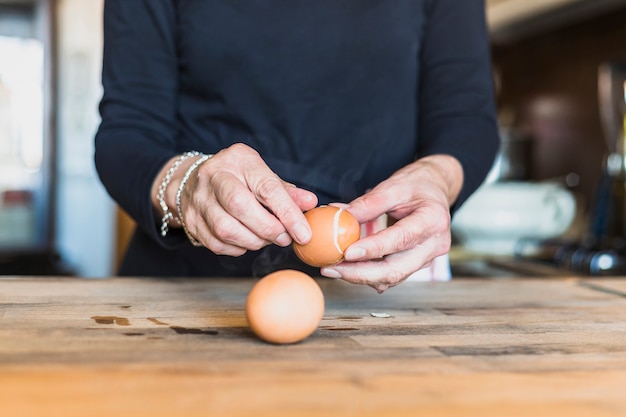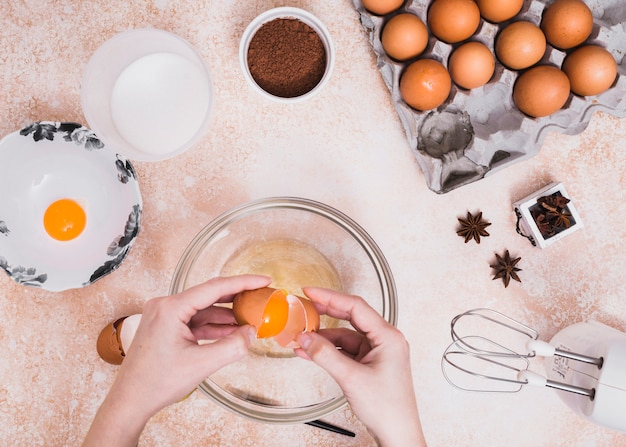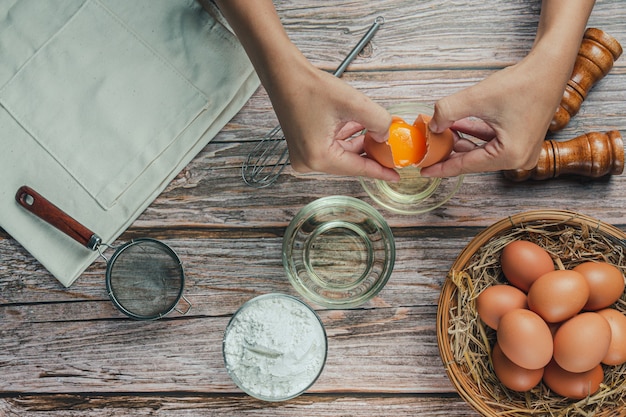Eggs are a kitchen staple, a versatile ingredient that can be whipped up for a quick breakfast or become the star of a fancy dinner. But let's be honest, there's nothing worse than ruining a good egg by overcooking it, ending up with a rubbery yolk or a runny white. It's a real egg-stential crisis!
Fear not, fellow egg enthusiasts, because I'm here to demystify the art of cooking the perfect egg. I'll guide you through the different methods, provide precise timings, and even share some insider tips and tricks I've picked up along the way. So, grab your pan, a timer, and let's get cracking!
(Part 1) The Boiling Point: Classic, Versatile, and Essential

boiling eggs: A Culinary Classic
Boiling eggs is a simple technique, but even this classic method has its nuances. My top tip? Always start with cold water. This ensures even cooking and prevents the eggs from cracking. Now, we all know the horror of a hard-boiled egg with a green ring around the yolk – a clear sign of overcooking. To avoid this, I swear by my grandmother's trick: adding a teaspoon of salt to the water. This helps prevent the eggshells from cracking and keeps the eggs from turning that dreaded green hue.
Once the water reaches a rolling boil, it's time to start timing.
How Long to Boil an Egg: The Perfect timing guide
| Desired Texture | Boiling Time |
|---|---|
| Soft Boiled | 3-4 minutes |
| Medium Boiled | 6-7 minutes |
| Hard Boiled | 8-10 minutes |
Cooling Down for Effortless Peeling
After your eggs are cooked, resist the urge to leave them in the hot water! This can lead to tough, difficult-to-peel eggs. Instead, immediately run them under cold water or plunge them into an ice bath to stop the cooking process. This also makes peeling a breeze, no more stubborn shells!
hard boiled eggs: A Blank Canvas of Culinary Possibilities
Don't be fooled by the humble hard-boiled egg. It's far from boring! It's a blank canvas, ready to be transformed into delicious salads, hearty sandwiches, decadent deviled eggs – the possibilities are truly endless!
Tips for Perfect hard-boiled eggs
- Add a tablespoon of vinegar to the boiling water. This helps prevent cracking and ensures a smoother peeling experience.
- Resist the urge to overcook! A slightly undercooked yolk is much more appealing than a tough, rubbery one.
- Store hard-boiled eggs in the refrigerator for up to a week, ensuring they stay fresh and ready for culinary adventures.
(Part 2) The Frying Pan: A World of Egg-cellent Possibilities

Sunny-Side Up: A Simple Delight
sunny-side up eggs epitomize weekend brunch, a simple yet satisfying dish. The runny yolk, the golden crust – it's pure comfort food heaven! But mastering this technique takes a touch of finesse. You'll need a non-stick pan, low heat, and a steady hand. Crack your egg directly into the pan, and cook gently, allowing the white to set while the yolk remains gloriously runny.
Tips for perfect sunny-side up eggs
- Use low heat to prevent burning the delicate egg white. Patience is key!
- Add a tablespoon of water to the pan to create steam, helping to cook the egg more evenly.
- Resist the urge to poke or prod the yolk. It'll break, ruining the beautiful presentation, and nobody wants that!
Over-Easy: The Next Level of Frying Mastery
over-easy eggs are essentially sunny-side up with a slight twist. The yolk is cooked just a little more, giving it a firmer texture. The secret lies in flipping the egg over for a few seconds before it's fully cooked.
Tips for perfect over-easy eggs
- Use a spatula to gently lift the egg white, allowing the yolk to flow out. A delicate touch is essential!
- Flip the egg over for a few seconds to gently cook the yolk. It's all about achieving that perfect balance between runny and firm.
- Don't overcook! You want the yolk to remain soft and runny.
scrambled eggs: The Ultimate Comfort Food
Scrambled eggs are a true classic, simple to make yet incredibly satisfying. But a few tricks can elevate them to a whole new level of deliciousness.
Tips for perfect scrambled eggs
- Use a fork to whisk the eggs instead of a whisk. This creates smaller, more delicate curds for a smoother texture.
- Add a splash of milk or cream for extra creaminess. It's a simple addition that makes a world of difference.
- Cook over low heat, stirring constantly. This prevents the eggs from becoming rubbery and ensures even cooking.
- Remove them from the heat when they're just set. The residual heat will continue to cook the eggs slightly, resulting in a perfectly cooked scramble.
(Part 3) The Oven: For Baking and Beyond

Baked Eggs: A Fancy Touch
Baked eggs might sound fancy, but trust me, they're surprisingly easy. Simply bake the eggs in a ramekin or muffin tin, and get creative with toppings.
Tips for Perfect Baked Eggs
- Grease the ramekins or muffin tins with butter or cooking spray to prevent sticking. A light touch goes a long way!
- Add a pinch of salt and pepper to the eggs before baking. It's a simple step that elevates the flavor.
- Bake for 10-15 minutes, or until the eggs are set and the yolks are slightly runny. It's all about achieving that perfect balance!
Shakshuka: A Middle Eastern Delight
Shakshuka is a dish that's been captivating tastebuds for ages. It's a symphony of flavors: eggs baked in a spicy tomato sauce.
Tips for Perfect Shakshuka
- Use a heavy-bottomed pan for even cooking. This ensures the sauce simmers gently and doesn't burn.
- Don't overcook the eggs. You want those yolks to be runny and creamy, adding a luscious texture to the dish.
- Top with fresh herbs and feta cheese before serving. It's the finishing touch that elevates this dish to a whole new level of deliciousness.
(Part 4) The Microwave: A Quick Fix for Those Busy Mornings
microwave eggs: The Quick and Easy Option
I'll admit, I was skeptical about microwave eggs at first. But sometimes you just need a quick and easy breakfast, and they deliver!
Tips for perfect microwave eggs
- Use a microwave-safe bowl or mug. Safety first!
- Add a tablespoon of water to the bowl. This prevents the eggs from drying out, resulting in a more tender, enjoyable texture.
- Microwave on high power for 30-60 seconds, or until the eggs are set. It's all about finding the right balance of cooking time for your microwave.
- Be careful when removing the eggs from the microwave. They'll be hot! Use a potholder or oven mitt to avoid any mishaps.
(Part 5) Beyond the Basics: Exploring Other Egg-cellent Techniques
Eggs Benedict: A Brunch Staple
Eggs Benedict is a classic brunch dish that's sure to impress. It features poached eggs on english muffins with a creamy hollandaise sauce.
Tips for Perfect poached eggs
- Use fresh eggs. They're less likely to fall apart during the poaching process, ensuring a perfectly formed egg.
- Add a splash of vinegar to the water. This helps the eggs hold their shape, preventing them from spreading out too much.
- Cook the eggs for 3-4 minutes, or until the whites are set and the yolks are still runny. It's a delicate dance of timing to achieve that perfect texture!
- Remove the eggs with a slotted spoon and drain on kitchen paper. This removes any excess water, ensuring a clean, delicious presentation.
Omelets: A Canvas for Creativity
Omelets are another fantastic way to cook eggs. They can be folded in half or rolled up, and they're a blank canvas for adding a variety of fillings.
Tips for perfect omelets
- Use a non-stick pan and cook over medium heat. It's all about achieving that gentle sizzle, allowing the omelet to cook evenly.
- Whisk the eggs with a splash of milk or cream for added richness and a fluffier texture.
- Pour the egg mixture into the pan and cook until the bottom is set. It's a delicate process, so keep an eye on it!
- Use a spatula to loosen the edges of the omelet and flip it over. It's all about mastering that delicate flip for a perfectly cooked omelet.
- Add your favorite fillings and fold the omelet in half or roll it up. The sky's the limit! Unleash your culinary creativity and experiment with different flavors.
(Part 6) Mastering the Art of the Egg: Key Takeaways
Freshness Matters: The Foundation of a Great Egg
Just like any other ingredient, using fresh eggs makes a world of difference. Look for eggs with a clean, fresh smell and a bright, vibrant yolk. Avoid any eggs that look cracked or damaged. It's all about choosing the freshest ingredients for the best results.
Experiment with Temperature: Finding the Sweet Spot
The temperature you cook your eggs at plays a crucial role in the final outcome. Low and slow is often best, especially when it comes to frying and poaching. It's about gentle cooking to preserve the delicate texture of the egg.
Don't Overcook: The Enemy of a Perfect Egg
Overcooking is the enemy of a good egg. Eggs are delicate, so keep a close eye on them and remove them from the heat just before they become rubbery. It's about knowing when to stop and achieving that perfect balance.
Be Creative with Toppings and Fillings: Unleash Your Inner Chef
Eggs are incredibly versatile, so don't be afraid to get creative with your toppings and fillings. From simple salt and pepper to more elaborate sauces and cheeses, the possibilities are endless. It's about finding your own unique style and flavor combinations.
(Part 7) FAQs: Your Egg-Cooking Queries Answered
1. Why do my eggs crack when I boil them?
Eggs can crack when boiled for a few reasons: they might be too cold, the water might be too hot, or they might be handled roughly. Adding a teaspoon of salt to the water can help prevent cracking, adding a bit of stability to the eggshell.
2. How do I get the perfect runny yolk?
For a perfectly runny yolk, cook your eggs for a shorter amount of time. If you're boiling them, aim for 3-4 minutes for a soft-boiled egg. If you're frying them, cook them gently over low heat and don't overcook them.
3. What's the best way to store eggs?
Store eggs in the refrigerator, preferably in their original carton. This helps maintain their freshness and quality. They'll last for several weeks in the fridge, ready for your next culinary adventure.
4. Can I freeze eggs?
Eggs can be frozen, but they won't be as good for frying or poaching. Freezing alters their texture slightly. They're best used in recipes that call for beaten eggs, such as baking or scrambled eggs.
5. What's the best way to peel hard-boiled eggs?
The best way to peel hard-boiled eggs is to cool them down quickly in an ice bath. This helps the shell to detach from the white, making peeling a breeze. You can also use a spoon to gently loosen the shell, working your way around the egg.
(Part 8) The End of Our Egg-straordinary Journey
And there you have it – my complete guide to cooking the perfect egg. I hope this has given you the confidence to experiment in the kitchen and create delicious egg-centric dishes. Remember, practice makes perfect, and with each attempt, you'll get closer to mastering the art of egg cooking.
So go ahead, grab your eggs and get cooking! And if you ever have any questions, don't hesitate to ask. Happy egg-cooking!
Everyone is watching

Prime Rib Roast Cooking Time Chart: Per Pound Guide
Cooking TipsPrime rib roast. Just the name conjures images of lavish dinners, crackling fires, and hearty laughter. It’s ...

How Long to Bake Potatoes in the Oven (Perfect Every Time)
Cooking TipsBaked potatoes are a staple in my kitchen. They're incredibly versatile, delicious, and surprisingly easy to m...

Perfect Rice Every Time: The Ultimate Guide to Cooking Rice
Cooking TipsAs a self-proclaimed foodie, I've always been a bit obsessed with rice. It's the foundation of countless cuisi...

The Ultimate Guide to Cooking Asparagus: Tips, Techniques, and Recipes
Cooking TipsAsparagus. The mere mention of this spring delicacy conjures up images of vibrant green spears, crisp and burs...

Ultimate Guide to Cooking the Perfect Thanksgiving Turkey
Cooking TipsThanksgiving. Just the word conjures up images of overflowing tables laden with delicious food, the scent of r...
